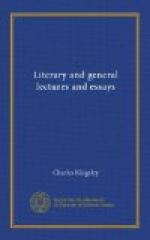The mystic, on the other hand, believes that the invisible world is so by its very nature, and must be so for ever. He lives therein now, he holds, and will live in it through eternity: but he will see it never with any bodily eyes, not even with the eyes of any future “glorified” body. It is ipso facto not to be seen, only to be believed in; never for him will “faith be changed for sight,” as the popular theologians say that it will; for this invisible world is only to be “spiritually discerned.”
This is the mystic idea, pure and simple; of course there are various grades of it, as there are of the popular one; for no man holds his own creed and nothing more; and it is good for him, in this piecemeal and shortsighted world, that he should not. Were he over-true to his own idea, he would become a fanatic, perhaps a madman. And so the modern evangelical of the Venn and Newton school, to whom mysticism is neology and nehushtan, when he speaks of “spiritual experiences,” uses the adjective in its purely mystic sense; while Bernard of Cluny, in his once famous hymn, “Hic breve vivitur,” mingles the two conceptions of the unseen world in inextricable confusion. Between these two extreme poles, in fact, we have every variety of thought; and it is good for us that we should have them; for no one man or school of men can grasp the whole truth, and every intermediate modification supplies some link in the great cycle of facts which its neighbours have overlooked.
In the minds who have held this belief, that the unseen world is the only real and eternal one, there has generally existed a belief, more or less confused, that the visible world is in some mysterious way a pattern or symbol of the invisible one; that its physical laws are the analogues of the spiritual laws of the eternal world: a belief of which Mr. Vaughan seems to think lightly; though if it be untrue we can hardly see how that metaphoric illustration in which he indulges so freely, and which he often uses in a masterly and graceful way, can be anything but useless trifling. For what is a metaphor or a simile but a mere paralogism—having nothing to do with the matter in hand, and not to be allowed for a moment to influence the reader’s judgment, unless there be some real and objective analogy—homology we should call it—between the physical phenomenon from which the symbol is taken, and the spiritual truth which it is meant to illustrate? What divineness,




